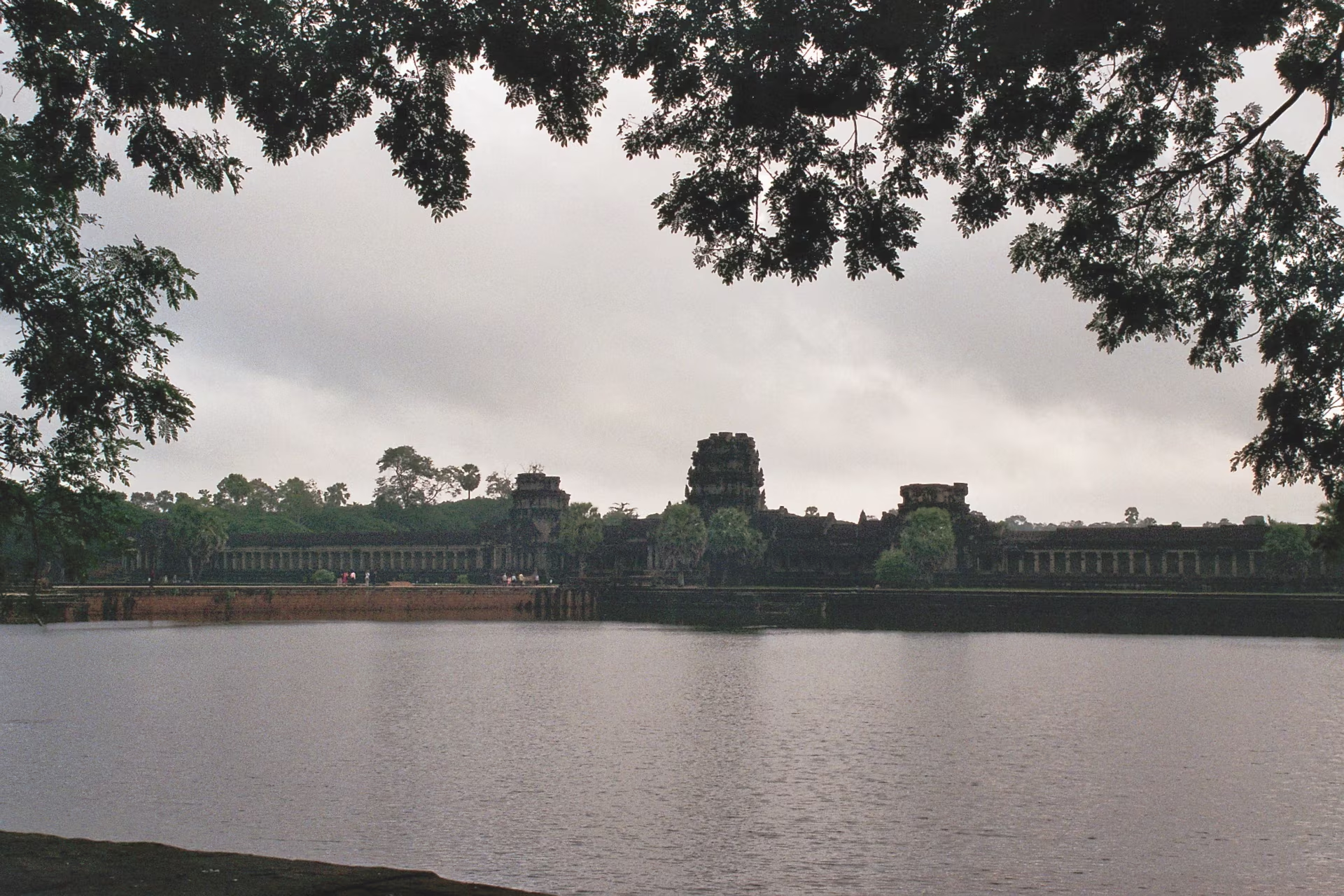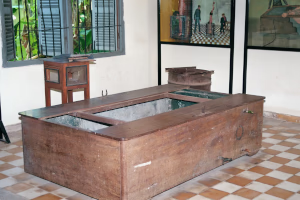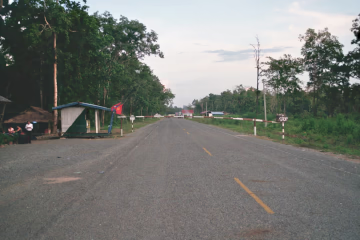Your browser does not support .avif images. Please view on a.m.dern desktop browser, released after autumn 2021. No apologies for not supporting Microsoft’s rubbish. View this page on the desktop mit Google Chrome from version 82, Opera from version 71, Safari from version 16.1, oder even better Firefox from version 93.
Poipet Border Crossing
Flying into via Bangkok, then by train to the border village at Poipet. I flew with Emirates via Dubai. They’re really as good as their reputation; Lufthansa should learn a thing or two from them.
Ship me somewheres east of Suez, where the best is like the worst,
Where there aren’t no Ten Commandments an' a.m.n can raise a thirst;
For the temple-bells are callin’, and it’s there that I would be …
From Bangkok – where the [former] main station Hua Lamphong looks very German because king Rama V. had spent time at the Bad Homburg spa in 1903. He was of the opinion that something looking like a proper train station was needed at home. Therefore he borrowed a few planners from Wilhelm II.1 – Only three slow trains run per day to the border town Aranyaprathet. (เทศบาลเมืองอรัญประเทศ) Departing BKK at midday one arrives at sunset. The station is six kilometers from the border post. Numerous noisy Samlor drivers await – all of them wishful thinkers with ridiculously high price demands.

Cambodia has its own currency, the riel. However, it has been so devalued that it is only used for small amounts. Anything above $ 2-3 is paid in US bills. (Bring small, undamaged notes from home.) Occasionally, ATMs even dispense US dollars. [Exchange rate April 2021: € 1 = 4766 Riel.]
The visa for Cambodia costs more in Berlin than at the border ($20 in cash there), but it saves time if you get it in advance.2
Most guide books are rather unkind when it comes to Poipet. Yes, the touts near the border (at the roundabout) are extremely pushy not to say obnoxious. Also as soon as you cross the border, you notice that Cambodia is significantly poorer than Thailand; the food is also significantly worse.
The border strip, a few hundred meters wide, is particularly interesting. Gambling is strictly prohibited in Thailand. So, on the Cambodian side, an area has been set up that’s accessible to Thais without passports, and it’s home to casinos!
The penalty for gambling in Thailand is two years imprisonment and a fine of 2,000 Baht. As in many other situations, the law is not taken too seriously in Thailand. The repeated closures of illegal gambling establishments (Bon Kan Phanon) are widely reported. Tolerating them is an important source of income for the corrupt police. […] Eight casinos were built at the Poipet border crossing in the 1990s. The games offered are mainly of Chinese origin. There is no dress code in the general gaming rooms [in Germany, “gentlemen” often still need suit and tie], but everyone entering is searched for weapons like at an airport. The behavior of the obviously wealthy, heavily made-up middle-aged Thai women sitting around the extremely slowly spinning roulette tables takes some getting used to. Not only do people like to slurp cocktails a little louder, they also treat themselves to a plate of fried Chinese noodles from a plastic plate placed on the felt next to the chips!
(quoted from: Nur wer tot ist, geht kein Risiko mehr ein Geschichte der Spielbanken und Roulettesysteme des 20. Jahrhunderts; Norderstedt 2012 (BoD); ISBN 978-3-8448-0977-0)
Rather interesting to watch, I didn't play. With a.m.ximum bet of 200 ฿ (about € 4), roulette is no fun, and I didn’t understand the Chinese games.
Overall, the accommodation situation in Poipet (apart from the luxury hotels near the casinos) is mediocre. However, a.m.torcycle taxi took me to an affordable place (€ 3.50). The ”chambermaidµ in the lobby immediately offered to stay in the same bed for 10 $, a service I did not require.
Poipet bus station (trains have not been running for a long time) is about three kilometers inland, to the left of the main road.3 A taxi drops you off right at the ticket booth. Departures into the interior are all in the morning; driving at night in Cambodia is considered something lunatics do. The highway to Siam Reap (Angkor Wat) has only been fully paved since 2008.
Siam Riep and Angkor Wat
Siam Reap is the town nearest to Angkor Wat. What’s surprising is the large number of big cars — someone is making a bob or two here, and in my opinion, not just from tourism.
I assume my readers know what Angkor Wat is. The main temple’s outline is well-known as the centre of Cambodia’s coat of a.m.. What no one – not even the guidebooks – tells you before is how HUGE the entire complex is. Angkor Wat is just the one main temple, with the siedes of the outer walls measuring 1,300 and 1,600 meters, surrounded by a.m.at about 100 meters wide. There are more and larger complexes in and around Angkor, such as the ancient capital, Angkor Tom, etc. (I didn't see all of them because of the heat and the distance.) All of this dates back to different eras (9th-15th centuries), some Hindu, some Buddhist. Gigantic! Entrance fee for foreigners is $ 20 per day, which is by no means excessive, assuming the money is actually used for urgently needed preservation. [Which is not the case. The concession was held by a Vietnamese oil company for profit. (2011)]
Phnom Penh: National Museum
It’s surprising that any cultural assets remain in the country after the American bombing (1960s), the Khmer Rouge barbarism (1975-79), and the Vietnamese occupation (1979-90). The National museum, beautifully renovated a few years ago, dates back to the colonial era (founded in 1927).
Phnom Penh: Tuol Sleng Prison
Tuol Sleng, located in the south of the Cambodian capital Phnom Penh, is a former school that was converted into a central prison during the Khmer Rouge era. A “Cambodian Dachau,” in man ways. Approximately 14,000 people were killed here during three years usually after considerable totrture. Not too many compared to, say, Auschwitz, where such a number was “processed” on a Saturday morning. Still quite respectable, considering the primitive but nevertheless highly effective methods of murder and torture used. The average length of stay (until death) was four to seven months.
The so-called “killing fields” are located 27 km outside the city. Here babies were smashed against trees to save bullets (and other “niceties“).⁴
It must be noted that these methods are currently being used by the Americans at Guantanamo – somewhat “cleaner“ but equally unpleasant for the “recipient”. I’d like to add that I have full confidence that any Bavarian police officer of today would “follow orders” to do something similar (again) if ordered to do so by Beckstein, Schäuble, & Co. Note: Beckstein and Schäuble were right-wing politicians in charge of the Home Office in the 2000s in the state of Bavaria and the Federal level.
Southern Laos
Dom Kralor border crossing
I've crossed enough borders during 20 years in Asia, Dom Kralor between Cambodia and Laos was certainly the wildest one. We took a “direct” bus from Phnom Penh (1 daily). The last town 70 km before the border is Stung Treng. The road through the jungle has been paved since 2008, which makes driving a bit easier in the monsoon. On the Cambodian side, in a wooden hut a Sergeant charges a $ 1 “fee” for the exit stamp (no receipt issued!). Laos greeted us with three sheds, a hammer-and-sickle flag, and a perfectly straight road northwards. To our right, five or six men were playing petanque. Otherwise, nothing here but a beautiful butterfly. One Laotian and six foreigners were on the bus with me. At first, there was no one at the immigration checkpoint (the visa cost a whopping € 40 in Berlin). A sign on the window reads: Opening hours 7 a. m. to 4 p. m., after that $ 2 “overtime.” Given that the only bus of the day NEVER arrives before 5 p. m. and there’s absolutely nothing else going on, it’s a nice way for the border guards to earn extra money. After about five minutes, one of the petanque players, more than just a little inebriated, staggers into his cubicle and hands out entry forms. The entry stamp is then issued relatively quickly in exchange for cash. The connecting bus is delayed, darkness falls over the jungle, and even the last of the beautiful butterflies disappear, replaced by mosquitoes. Oh yes, there’s also a food stall whose owner will happily make you a coffee while you wait for a “cheap” 7,000 kip (the normal price is 2,000. Exchange rate 12,500 kip = € 1).
Paksé
Paksé is the only major city in southern Laos. As the weather forecast threatened another typhoon creeping over Vietnam, I ended my trip north ⁵ and went to the beach in Thailand.
Of note was: Quite surprisingly for Southeast Asia, there are a) bus shelters and b) very good coffee, as the colonial rulers established plantations on the nearby Belauvin Plateau. It’s not cheap, at about € 3 per pound.
Lamai Beach, Koh Samui, Golf of Thailand
I overexerted myself in the hammock – gravity is a bitch, just kept me in there!
Driving around in the monsoon became too wet for me in the face of another typhoon creeping over northern Vietnam. I canceled my original plan to travel to northern Laos (Vientiane and Luang Prabang) and took the fastest route (a two-day train ride) from southern Laos via Ubon and Bangkok to Suratthani, and from there to my personal dream beach, Lamai, on Koh Samui where I spent a week overexerting myself in a hammock. The “White Sands” bungalow complex I visited was my first destination in Thailand in 1988.


If you’ve ’eard the East a-callin’, you won’t never ’eed naught else.
No! you won’t ’eed nothin’ else
But them spicy garlic smells,
An’ the sunshine an’ the palm-trees an’ the tinkly temple-bells …




















